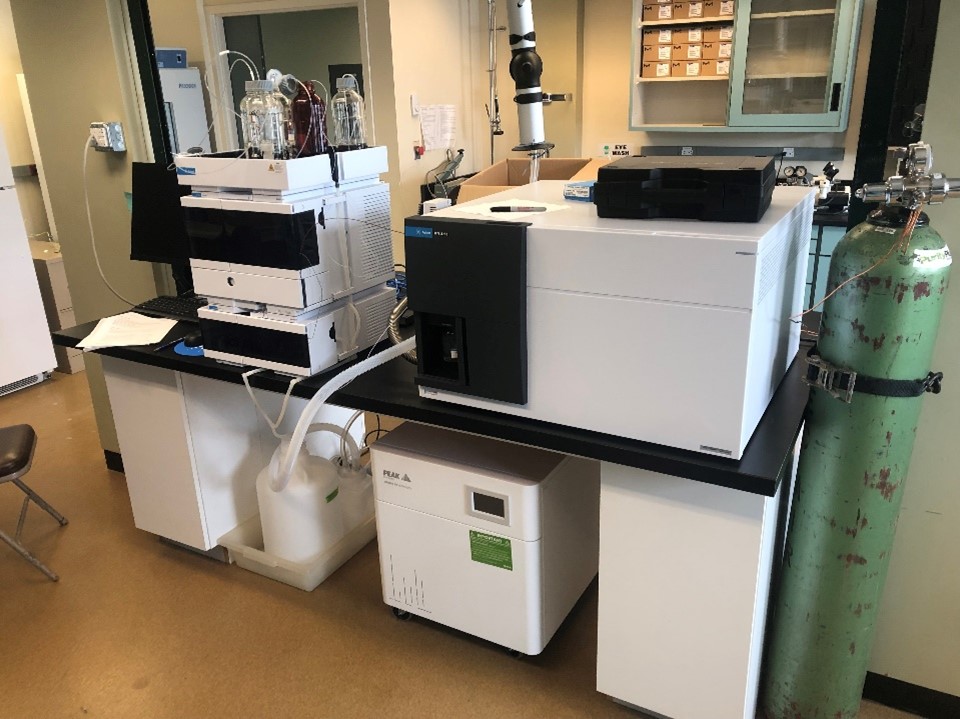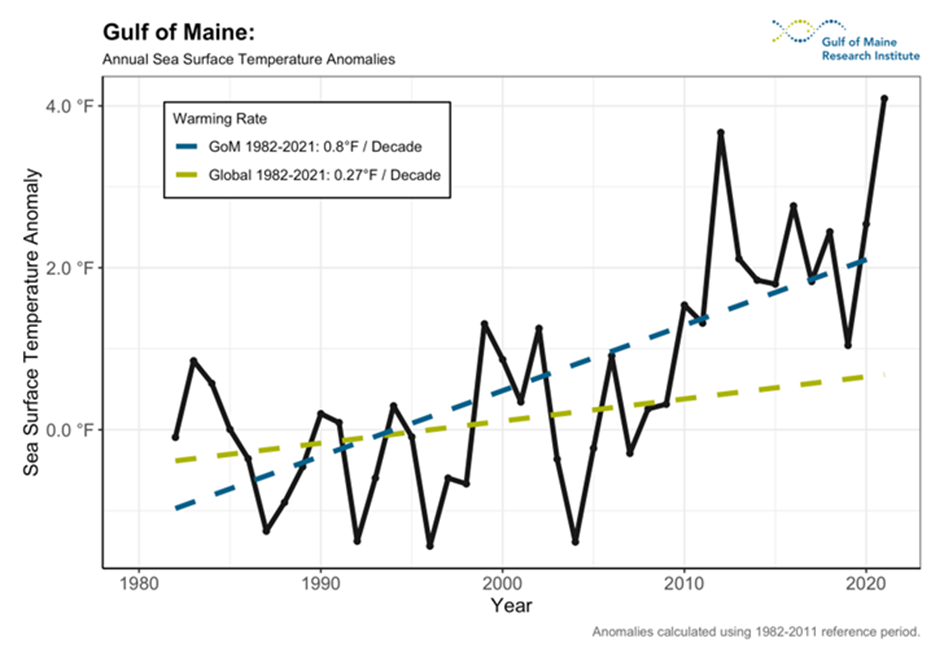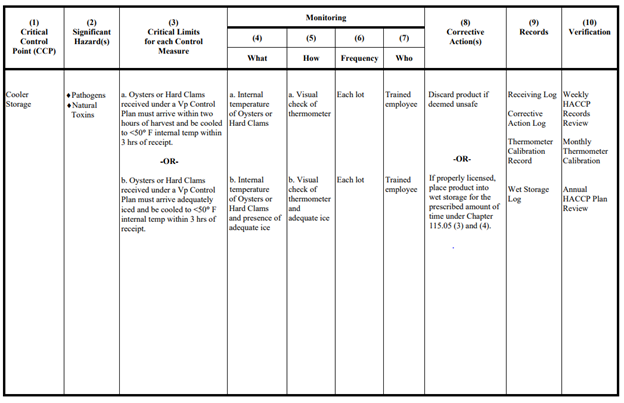Index
- Atlantic Sea Scallops in Maine
- Water Quality Sampling - More Than Just Bacteria!
- Digging into Marine Worm Populations
- New Instrument in Shellfish Sanitation Lab to Greatly Expand Testing Capabilities
- The Aquaculture Division joins the Bureau of Public Health
- Municipal Shellfish Management Meetings - We Heard You and It Didn't Stop There!
- The Importance of Vibrio Control Measures
Atlantic Sea Scallops in Maine
By David Miller, Eastern Maine Growing Area Program Supervisor
Currently and historically wild caught Atlantic sea scallops (Placopecten magellanicus) harvested in Maine must be shucked at sea and only the adductor muscle may be retained and landed for personal use, wholesale, or retail trade. This regulation is primarily driven by documented evidence that scallop viscera and gonads readily assimilate certain biotoxins and in some instances may amplify toxicity through internal metabolic processes. That said, it cannot be emphasized strongly enough that there are no biotoxin threats found in the scallop adductor meats landed in Maine.
Several years ago, a pioneering group of aquaculturists, working with Maine Sea Grant and Bigelow Laboratory for Ocean Sciences, approached the Maine Department of Marine Resources (DMR), Bureau of Public Health to determine if a regulatory testing process could be developed that protects public health while allowing the harvest of live whole or roe-on scallops from their lease sites. With adequate safeguards in place, the group envisioned an opportunity to satisfy increasing market demand for this product.
Maine DMR considers whole or roe-on scallops a high-risk biotoxin species, however, in response to industry inquiry a biotoxin monitoring program for farm-raised whole or roe-in scallops was developed that minimizes potential toxin risk. Prior to initial harvest producers must collect three live whole scallop samples (12 -15 individuals) each seven days apart from their lease site and send them to an FDA-certified private laboratory for analysis. Currently, Bigelow Laboratory for Ocean Sciences is the only certified private laboratory. The grower is responsible for the costs associated to obtain sample results and these costs are considerable- sample collection from a site, transport to land, specimen cost, transport to a lab, and testing fees to name a few.
Once results from the three tests are realized and are below biotoxin closure thresholds an Exception is granted by DMR allowing specific lease site harvest of whole or roe-on scallops. From that point forward the leaseholder must continue to provide scallop samples for testing. DMR determines the testing frequency and is based on scallop results combined with data from the rigorous biotoxin tissue analysis and phytoplankton program DMR routinely conducts statewide. Since inception, the live whole or roe-on scallop aquaculture biotoxin testing program in Maine has been successful and with each sampling season refinement continues as the lease-specific data become more robust.
Water Quality Sampling - More Than Just Bacteria!
By Eric Sroka, Marine Resource Scientist II
Following a typhoid fever outbreak during the winter of 1924, the Surgeon General of the United States Public Health Service was requested to develop controls to ensure shellfish would be protected against communicating disease to the public. On February 19, 1925, a conference was held in accordance with this request. The recommendations that came out of the conference were to be the basis for the development of the National Shellfish Sanitation Program (NSSP).
The NSSP went beyond the original objective set forth in the conference, growing to encompass more than bacterial or viral contamination. In the 1940s the NSSP began to focus on paralytic shellfish poisoning, adding radionuclides in 1957 as a potential contaminant. In the 1960s and 1970s, various other hazardous substances were understood to accumulate in shellfish, also indicating a need to track them.
Broadly speaking, shellfish contamination can occur in two categories: chemical and biological. Chemical contaminants can include such substances as mercury, polychlorinated biphenyls (PCBs), microplastics, and pharmaceuticals. Common biological contaminants include bacteria and viruses. Fecal coliform bacteria, which is commonly found in human and animal waste, is a good indicator of the presence of some of these other harmful substances since many are also associated with fecal waste and wastewater.
The Water Quality program of the Public Health Bureau routinely monitors for fecal contamination by collecting water samples to determine fecal coliform concentrations within shellfish growing areas. In accordance with NSSP guidelines, these bacteria counts are one of the primary components in determining the classifications of growing areas. However, particularly around areas of wastewater treatment plants and other such discharge sources (overboard discharges, etc.), low bacteria concentrations may not tell the whole story. Wastewater treatment facilities typically chlorinate or otherwise sterilize discharge water, effectively removing bacterial contamination- but those efforts may be ineffective against viruses or chemicals. Precautionary closures around these discharges protect public health against these contaminants. There is a lot of information stored in the 100 milliliters the Water Quality program collects!
Digging into Marine Worm Populations
By Ari Leach, Marine Resource Scientist II
The Nearshore Marine Resources Program (NMRP) in the Department of Marine Resources (DMR) has been working closely with stakeholders from the marine worm industry in Maine to address concerns surrounding population numbers, landings, and climate change pressures. The harvesters in Maine dig for bloodworms and sandworms to ship all over the world to use as prized bait for recreational fishing.
During the fall of 2022, DMR and the NMRP were approached by the Independent Maine Marine Worm Harvesters Association (IMMWHA) with concerns of low population numbers across the state and a desire to explore potential causes for the decline. Using location information from harvesters, the NMRP designed a marine worm larval supply study that would take place in two coves near Wiscasset during the May-June spawning season.
The larval supply study involves towing a fine-mesh plankton net behind a small skiff to collect any larvae that may be present in the water column. The team also sampled eDNA from the water using a filter sampling system borrowed from our collaborator Brian Tarbox (Southern Maine Community College). With the help of SMCC, the NMRP hopes to be able to identify DNA from marine worms in the water column, which will provide valuable data for the project.
In addition to the larval tow and eDNA sampling, the team deployed 9 wood and mesh screen recruitment boxes at each site. These recruitment boxes will remain in the mudflat until the fall, then any material that has settled into the boxes will be sorted and identified. The boxes will hopefully capture larval marine worms and trap them as they grow, providing yet another valuable data set.
As the field sampling for this project wraps up, the NMRP is looking forward to the DNA analysis of the samples and adjusting the protocols that will improve future work. This season presented various challenges and learning opportunities, and the team worked hard to overcome and adjust expectations. This important project will continue in 2024 and we look forward to sharing results as they become available.
New Instrument in Shellfish Sanitation Lab to Greatly Expand Testing Capabilities
By Tyler Spillane, Laboratory Technician III
The Shellfish Sanitation Lab recently purchased and installed a Liquid Chromatography – Mass Spectrometer (LC-MS). This is an extremely sensitive instrument that can accurately identify and quantify many naturally occurring biotoxin compounds in shellfish samples, as well as many other compounds of interest. The new instrument combines High-Performance Liquid Chromatography, like our systems used for ASP and PSP detection, with Mass Spectrometry, which detects mass/charge ratios of compounds to detect toxins at the parts per million scale.
This new instrument will allow us to test for biotoxins that we have been unable to easily monitor in the past. This includes biotoxins that cause Diarrhetic Shellfish Poisoning (DSP). Like Paralytic Shellfish Poisoning (PSP) and Amnesic Shellfish Poisoning (ASP), DSP is caused by a suite of biotoxins produced from phytoplankton common to Maine waters. The illness can cause severe gastrointestinal illness and abdominal pain but is typically non-lethal to humans. Previously we have been unable to reliably monitor for this toxin in-house at DMR, often having to outsource to other labs such as Bigelow Laboratories.
As the climate changes and the Gulf of Maine warms, we expect to see new species of phytoplankton enter our waters. These species can bring with them a new suite of biotoxins that can enter our shellfish and potentially impact humans. This new instrument will be key in detecting these new biotoxin compounds which will help DMR better manage our shellfish growing areas for public health. Having the testing capacity in-house means precautionary closures and long delays associated with sending samples to outside labs can be avoided.

The Aquaculture Division joins the Bureau of Public Health
By Amanda Ellis, Aquaculture Division Director
In the winter of 2023, functional oversight of the Aquaculture Division was moved from the Bureau of Policy and Management to the Bureau of Public Health (BPH). With this change, the Aquaculture Division has been able to leverage additional resources and expertise within BPH to enhance and streamline work and services offered to the many stakeholders served by the Aquaculture Division. It has also created opportunities for more collaboration between staff in BPH and the Aquaculture Division.
The Aquaculture Division is currently a team of eight individuals that work in various aspects of the program, which includes lease and license permitting in coastal waters and permitting certain aspects of land-based operations. The director of the Aquaculture Division is Amanda Ellis, PhD who is responsible for the general administration and management of the program. As the Director of the Bureau of Public Health, Kohl Kanwit provides oversight of the Aquaculture Division.
Over the summer, the Aquaculture Division will continue working with the Nearshore Marine Resources Program to develop a more streamlined application procedure for municipal shellfish programs that apply for Limited Purpose Aquaculture (LPA) licenses as part of their conservation work. This includes developing an LPA application specific to municipal applicants and offering some technical support in the completion of applications. As this work is finalized, further details and expectations will be communicated to municipalities. This coming fall, Aquaculture Division staff will also be attending the Regional Shellfish Committee meetings to talk about municipal involvement in the aquaculture leasing and licensing process and other considerations specific to aquaculture.
We look forward to being a regular contributor to this newsletter and providing you with updates about aquaculture. If you have questions about aquaculture, please email DMRaquaculture@maine.gov. This account is checked regularly, and you will receive a response.
Municipal Shellfish Management Meetings - We Heard You and It Didn't Stop There!
By William Fearn, Planning and Research Associate II
In May of 2022, the DMR Bureau of Public Health and the Shellfish Advisory Council (ShAC) held Municipal Shellfish Management meetings at three different physical locations along the coast of Maine with a fourth virtual meeting for those that couldn’t attend in person. We asked meeting participants the following questions.
- What does it look like to have an effective program?
- What do you see as the key components for success?
- What does your municipality currently do to address this issue?
- What additional strategies could be used?
- How could municipal shellfish programs be improved to address these issues?
- What ways could DMR and municipalities partner for a more effective municipal shellfish program to address this issue?
It’s been a little over a year since those meetings. You may ask yourself, “What has been done since?”. The answer is, A LOT!
Over the last year, the ShAC took all the information gathered (MSM Summary Report) and compiled it down to a list of 70 different topics spread over 9 different categories (MSM Presentation). The next step was to figure out who would be best to address which topics and how long each topic was expected to take, that breakdown can be seen here (MSM Matrix).
DMR, specifically the Bureau of Public Health was able to take on a number of these topics, and here is a list of what we have done since those meetings in May 2022.
- Regional Shellfish Meetings – We have set up an opportunity for Harvesters, Municipal Officials, and industry members to get together in their regions (Southern, Central, and Eastern) and discuss ideas, concerns, and solutions about their programs. DMR participates in these meetings as a facilitator and listener, only providing feedback or comment when requested.
- Nearshore Marine Resource Management – DMR has hired three additional Marine Resource Scientists to the Nearshore Marine Resources Program (formerly Shellfish Management Program). This increased capacity for providing better coverage of the Maine Coast for municipal shellfish co-management, as well as state-level management of marine worms, seaweed, mussels, periwinkles, whelks, and subtidal resources, with a new focus on considering management strategies in the context of climate change.
- Mini Grants – DMR was able to fund five mini-grants that will help improve municipal management and conservation programs.
- Gov Delivery – We have committed to growing our public outreach and getting the resources we already have available to those who want them. The best way to stay informed is through our Gov Delivery system.
Upcoming Developments
- Municipal Marine Resource Management Training – An upcoming program in 2024 will be a training focused on providing tools and information to those who help manage municipal resources. This training is intended for anyone who participates in Municipal Marine Resource Management, more information on the dates and locations will be advertised via our Gov Delivery System.
- Near Real-Time Water Quality Data - Water quality staff have created a workflow that will allow water quality station data to be published on the DMR Open Data Portal monthly. Data will be published as a downloadable spreadsheet which will include historic data from the preceding five years. Staff are in the final steps of a data quality control check then links will be added to the appropriate DMR webpages.
The Importance of Vibrio Control Measures
By James Becker, Seafood Technology Supervisor
Marine microbes make up more than 98% of the Earth’s ocean biomass, whereas on land microbes comprise only about 2% (Bar-on & Milo, 2019). Simply put, most of the life in our oceans are tiny single-celled organisms. Of these are a type of bacteria in the genus Vibrio, which can cause health problems and illnesses when consumed by humans via raw shellfish like oysters and hard clams. A single adult oyster can filter 50 gallons of water per day (NOAA, 2020), and in the process, uptake bacteria. Once bacteria are in the shellfish they can proliferate if the shellfish are handled improperly. If bacteria are allowed to increase through temperature abuse, then they can cause a serious illness called Vibriosis. However, problems can be prevented or minimized by cooling shellfish rapidly starting at the point of harvest, all the way to the dinner plate.
Under certain environmental conditions, Vibrio will follow a specific population growth pattern, with relatively low numbers in the beginning, followed by exponential growth to levels high enough to cause illnesses. Once the necessary surrounding ingredients and nutrients are depleted, the biomass reaches a maximum capacity and stabilizes at what is called a stationary phase. This growth pattern can be curtailed before reaching unsafe numbers by implementing time and temperature limits outlined in state regulations called a Vibrio Control Plan. Many states require a Vibrio plan, some differ from others, but all are based on rapid cooling to prevent bacterial growth. Here in Maine, we use our own control plan outlined in Chapter 115: https://www.maine.gov/dmr/fisheries/shellfish/maine-dmr-vibrio-education, implemented every June 1 through October 15, during the warmest and most optimal time of year for Vibrio growth.
Temperature is the main driver for the growth of Vibrio and the rate at which it can reach unsafe levels for human consumption of raw shellfish (Sheikh et al., 2002). The optimal growing temperature is between 68-95°F (Fish and Fishery Products Hazards and Controls Guidance, 2011 and Florida Dept of Health, 2022). With the Gulf of Maine being one of the fastest warming saltwater bodies on the planet (Gulf of Maine Research Institute, 2023), concerns for increases in Vibrio and related illnesses, awareness, and proactive measures are necessary (Figure 1).
To hamper bacterial growth, Maine state regulations require Vibrio-licensed harvesters to deliver oysters and hard clams from the control areas to a Vibrio-licensed shellfish dealer within 2 hours of harvest or use ice immediately during harvest (Figure 2). Furthermore, the receiving dealer must get the shellstock to below 50 F within 3 hours of receipt, whether arriving surrounded in ice or not. Through the use of these regulations, Maine has avoided Vibrio illness outbreaks!
Recognizing the health concerns that can be associated with certain shellfish, Vibrio bacteria, and the correlations to temperature and warming oceans helps explain the importance of control plans and measures when harvesting and handling shellfish that may be eaten raw. Following the regulations of Maine’s own Vibrio Control Plan will help protect the public and the amazing and ever-growing Maine shellfish industry.

Figure 1. Time series of annual average SST for the Gulf of Maine (solid black line) from 1982 through 2022, illustrating that 2022 was the second warmest year on record. Long-term trendlines for the Gulf of Maine (blue) and the entire globe’s ocean surface (green) show how much more quickly the Gulf of Maine is warming compared to the rest of the world’s oceans (GMRI, 2023).

Figure 2. Vibrio HACCP plan required for corresponding dealers, highlighting in red the harvester and receiving dealer time and temperature regulations.
For more information, you can visit our website and you can visit the regulations found in the NSSP Model Ordinance